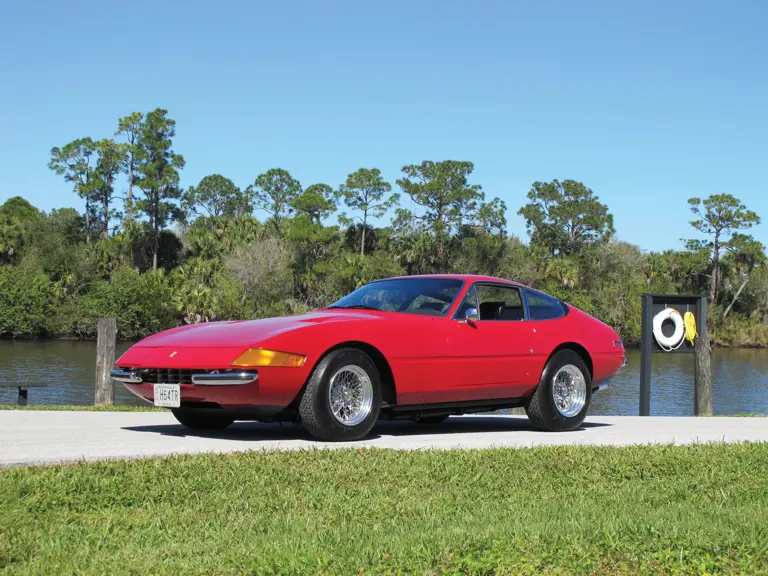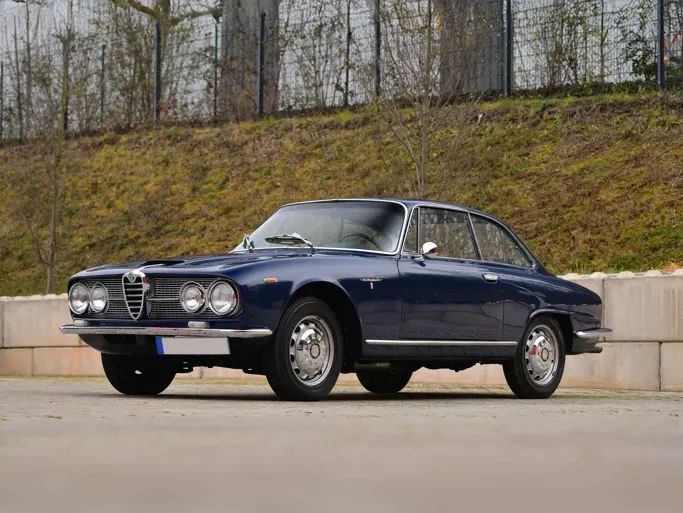
1971 Ferrari 365 GTB/4
{{lr.item.text}}
$649,000 USD | Sold
{{bidding.lot.reserveStatusFormatted}}
- 4.4-liter, 352-hp DOHC V-12 engine
- Five-speed manual transaxle
- Six Weber carburetors
- Introduced as world's fastest production car
- 1,273 produced from 1968 to 1973
- Original mileage
- Air conditioning
- Borrani wire wheels
- Knock-offs
- Original books and toolkit
The Ferrari 365 GTB/4 wasn’t called the Daytona on the cover of the October 1970 Road & Track magazine; it was called “Our Fastest Road Test Car.” The 365 GTB/4 was immediately recognized as being special in the realm of exotic automobiles. Road & Track exuded:
“It might as well be said right now. The Ferrari 365 GTB/4 is the best sports car in the world. Or the best GT. Take your choice; it’s both. And we really didn’t expect it to be. After all, it’s not the most exotic – the engine is still up front, per tradition, so it can’t have the exotic shape of a mid-engine car or the fascinating sights of engine-transaxle units turned sideways and revealed by lifting half the body. It doesn’t have the outright handling capability of the mid-engine car either. But Ferrari, who has built so many racing midengines, has stayed away from that layout for his fastest road car, perhaps wisely so if his aim is to build the greatest all-around blend of speed, handling and refinement. For the 365 GTB/4 is that.”
These are a few of the reasons that the Ferrari “Daytona” is still exalted 45 years later and commands attention whenever they come to life at a warming idle to the sheer power experienced when grabbing fifth gear at 7,500-rpms on your way to the advertised 180-mph top speed.
Ferrari’s 365 GTB/4 was unveiled to the public at the 1968 Paris Salon as the replacement for the highly successful 275 GTB/4, and it sought to raise the bar once more for high-end gran turismo berlinettas. With lines penned by Leonardi Fioravanti at Pininfarina, its bodywork was an instant styling icon, as it was simultaneously sensuous and aggressive and combined both the sharp angles that would define the 1970s and the flowing curves that characterized cars of the 1960s, making it perfect for any occasion. Mr. Ferrari feverishly squashed any official use of the Daytona moniker after the name was inadvertently leaked to the press, it remains in popular use to this day, forever commemorating Ferrari’s 1-2-3 finish at the 1967 24 Hours of Daytona.
Brandishing a 4.4-liter V-12 engine mated to six Weber carburetors and a five-speed transaxle, the Daytona produced 352-hp and with a top speed of 174-mph, it was labeled, rightfully so, as the fastest production sports car in the world at the time. While the price of the Daytona rose from $19,500 to $23,940 over the course of its five-year production run; its appeal certainly never lessened. The Daytona went on to become the best-selling V-12 Ferrari of the vintage era and a grand total of 1,273 were produced from 1968 to 1973. Sadly, this would be Ferrari’s last front-engined two-seat grand tourer until the introduction of the 550 Maranello in 1996.
The first thing that may capture your eye when contemplating a 365 GTB/4 is its almost provocative sobriety. Not the slightest artifice disturbs the surface of this flowing shape; smooth as a pebble and only interrupted by a longitudinal crease and yet, far from seeming languid, it startles with its vigor. Its economy of line is somehow the height of its artistry.
Appropriately presented in red with black leather interior, this rousing Ferrari Daytona exhibits all of the traits that set it apart; the displayed mileage is approximately 76,000 and actual. The dash has analog Veglia instruments to monitor the car’s systems and has non-glare suede covering per factory specs. Among the amenities are air conditioning, Becker Mexico AM/FM/cassette, power windows, power-assisted four-wheel disc brakes, Borrani wire wheels with knock-offs and Michelin XWX tires. Always a welcome addition to any Ferrari is its original books and toolkit, as found within this machine.
This is an automotive tour de force that no matter what use it is put to – the only limitations are the driver’s abilities. With the Ferrari 365 GTB/4, the era of front engine V-12s had drawn to a close; therefore the Daytona will forever be placed in history as the culminating point of a style; the last and most beautiful masterpiece in a line of cars doomed to extinction by the march of progress.


 | Fort Lauderdale, Florida
| Fort Lauderdale, Florida


